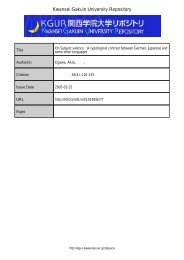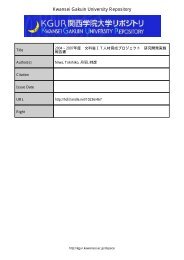Kwansei Gakuin University Repository
Kwansei Gakuin University Repository
Kwansei Gakuin University Repository
You also want an ePaper? Increase the reach of your titles
YUMPU automatically turns print PDFs into web optimized ePapers that Google loves.
6. Conclusions<br />
This paper has explored heterogeneous exits—bankruptcy, voluntary liquidation,<br />
and merger—by focusing on new firms. Using a sample of approximately 16,000<br />
firms founded in Japan from 1997 to 2004, we examined heterogeneities in the de-<br />
terminants of exit between different forms of exit up to 2009. Regarding industry-<br />
specific characteristics, our findings indicated that new firms in capital-intensive and<br />
R&D-intensive industries are less likely to go bankrupt. On the other hand, new<br />
firms in industries characterized by high capital intensity and low price–cost margins<br />
are more likely to exit via voluntary liquidation and merger. We also found that<br />
gross entry rate had significantly positive effects on exit regardless of form of exit.<br />
Region-specific characteristics, such as regional agglomeration and unemployment<br />
rate, had significant effects on exit, and their effects vary between different forms of<br />
exit. Moreover, we provided evidence that firm-specific characteristics, such as the<br />
number of employees, and entrepreneur-specific characteristics, such as educational<br />
background and age, play significantly different roles in determining the rate of each<br />
form of exit.<br />
However, our paper has some limitations. While we have examined the deter-<br />
minants of exit of new firms, we could not include some variables, especially those<br />
variables associated with financial conditions. New firms are likely to face difficulties<br />
in securing initial funds from external capital markets. Fotopoulos and Louri (2000b)<br />
and Huynh et al. (2010), for example, provide evidence that initial financial condi-<br />
tions are important factors in determining the exit of new firms. As Buddelmeyer<br />
et al. (2010) and Wagner and Cockburn (2010) found, intangible resources, such<br />
as patents and trademarks, may also have an impact on firm survival. Therefore,<br />
it is worthwhile investigating heterogeneity across new firms, which may indicate<br />
the capabilities and resources of new firms. In addition, it would be interesting<br />
to extend this research to other industries because, for example, service industries<br />
26
















